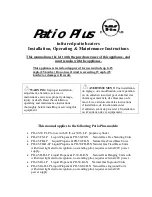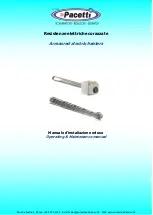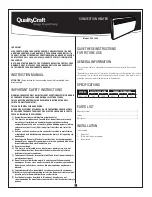
- 3 -
Positioning the unit
The water heater should be fitted level on a hard surface with sufficient load strength to take the full
weight of the cylinder (see table 1 page 1). There are no limitations regarding the fitting distance
from walls etc., but it is strongly recommended to ensure easy access to all pipe fittings etc. There
should be at least 80 cm of free space in front of the water heater to ensure easy access for servic-
ing and maintenance.
Protection from frost
If the water heater is in danger of being exposed to frost while not operating under electric power,
the unit must be drained to avoid damage. Make sure the electric power is turned off before drain-
ing, otherwise the heating elements can be damaged and the warranty is void. Draining instruc-
tions, see “Commissioning” on page 4.
Cold water supply
1. To obtain the best performance from your OSO unvented system it is advisable to feed the unit
with an uninterrupted supply.
2. Before connecting to the multibloc, flush the cold supply pipework of all flux and debris.
3. Locate the water heater in a suitable position to facilitate the installation of the cold water
supply, discharge fittings and pipework. Also take into account access to the immersion heater.
4. Fit the combined male elbow drain cock to cold supply point (13), so that the compression
fitting is vertical.
5. Fit the length of copper tube 22mm specified in Table 2 to the cold feed elbow (see 4 above)
to include a Tee piece if a secondary return is required
6. Fit the pressure reducing valve (3) to the top of the copper tube (see 5 above).
7. Connect 15mm copper tube from the expansion relief valve (4) and also from the T & P valve
(5) and join together in a Tee as shown on page 2
8. Fit the tundish (6) to the bottom connection of this tee.
9. If a balanced mains pressure cold water supply is required to a shower or bidet (over rim type
only), remove the blanking cap from the pressure reducing valve (3) and connect to the shower
or bidet cold supply.
Do not use this balanced cold outlet to feed all cold outlets.
10. Connect the cold supply to the PRV (3).
11. Fit the expansion vessel to the wall close to the water heater using the enclosed mounting
bracket. Connect the expansion vessel to the PRV, as shown on page 2.
Hot water supply
12. Connect the hot water supply pipe to the outlet (9). Ensure connection is water tight.
Secondary return (optional)
13. Connect secondary return if required to the Tee piece in the cold feed tube see 5 above (see
page 12).
Discharge pipe
14. Connect the discharge pipe from the tundish (6). This must have a continuous fall and be fitted
in accordance with The Building Regulations (see page 16). The tundish should be installed
away from electrical devices.
Boiler Primaries - Primary flow & return and motorised valve
15. The boiler primary flow and return connections should be made connections 1 & 2. The
motorized valve can be connected to either the primary flow or return pipe. The primary flow
and return fittings are 3/4’’ BSP female. The valve has 22mm x copper connections. The
direction of primary flow in the coil is bottom to top. The maximum operating temperature of the
primary flow would typically be 82°C.
16. For electrical connection of the motorised valve and immersion heater, please read Electrical
Installation Instructions. (Pages 7 - 11).
Tundish
Install theTundish in a vertical position within a maximum of 600mm from the temperature and
Pressure Relief Valve drain connection. Ensure the expansion relief pipework discharges through the
tundish. Tundish pipework must be 22mm with a minimum vertical length of 300mm below tundish.
Maximum permitted length of 22mm pipework is 9m.
Each bend or elbow is equivalent to 0.8m of
pipework.
All pipework must have continuous fall and discharge in a safe, visible position. If any doubt,
refer to
Building Regulation G3.
POSITIONING - COLD WATER SUPPLY


































